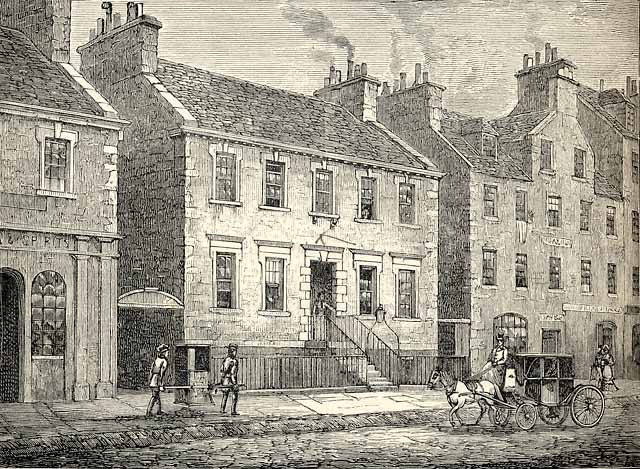A reminder: this is not TS (1772-1850); while researching him, I came across information about this fellow and thus have assembled it. That said, if you have something to add or refute, please feel free to contact me.Here’s what I know of Thomas Erskine Sutherland: he was, according to the admittedly unreliable IGI, born March 1, 1770, Edinburgh Parish, Edinburgh, Midlothian, Scotland, to William Sutherland and Isobell Noble. He received an education at
Heriot's Hospital, a charitable school found in the seventeenth century to educate “puir, fitherless bairns.” I haven’t looked for his parents’ obituaries, but by the late eighteenth century Sutherland need not have been an orphan to attend the school—as its finances became secure, the school admitted other needy children.
As of 1794 there is a TS, haberdasher, at North Bridge Street, Edinburgh, whose custom is valued enough that a vendor wishes people to know that this TS buys his materials from him (see
The Edinburgh Advertiser, March 25, 1794). And this address seems to remain consistent--a post office directory places him there in 1809, when he would have lready begun his family. There is a marriage record for TES to Margaret Watson, daughter of Alexander, June 9, 1793, in Edinburgh City, Midlothian. Appropriately, he passed his name on to what was probably his first child, Thomas Erskine Sutherland II, born in Edinburgh City, Midlothian, May 18, 1794. A short time later, TES received the popular vote in an election. James David Marwick in
Sketch of the History of the High Constables of Edinburgh, reports: “Thomas Sutherland, haberdasher. Elected Clerk Apr. 18. 1798.” We can assume that this is him because of an 1821 record from the Scottish Record Society (
Roll of Edinburgh Burgesses and Guild-Brethren, 1406-1841) which survives in the Scottish Record Society and identifies TES as a haberdasher. While there seem to be a surplus of Edinburgh tailors of the era with the last name Sutherland, this is the only haberdasher I’ve encountered. (Note: in the UK a haberdasher was a different entity than a tailor or men's outfitter; it is in only in the US that the meaning shifts.)
TES clearly established himself as a man of some note—his second marriage in 1809 was reported in both the
Gentleman’s Magazine and
The Scots Magazine and Edinburgh Literary Miscellany: “Thomas Erskine Sutherland, esq. of Edinburgh, to Miss Highley, of Fleet-street.” It is possible that Miss Highley was related to Samuel Highly, the well-known bookseller who had a shop on Fleet Street at that time. A cursory search revealed no trace of the fate of his first wife, but it was not unusual for women to die in childbirth or as a result of it.
TESII was not Sutherland’s only child. His son, Samuel Sutherland, according to one source, diedOctober 25, 1848 in “Vandreal, Canada”--
which could be a mistranscription of Montreal. And it seems likely that TES was the father of the ten year old girl, Heriot Sutherland, who died “of decline” Nov 2, 1826, “an inmate of the Merchants [Maiden] Hospital, daughter of Thomas Sutherland, of Post Office.” The
Merchant Maiden Hospital was also a charitable school, this one founded by Mary Erskine in 1694. It is notable that both Heriot and TES carry the names of those who founded charitable schools from which they could benefit; clearly this was a family which valued education in the face of adversity.
If Heriot was indeed his daughter, the family would soon be dealt a double blow. Slightly less than two months later a
report was issued: “Dec 29,1826, Mr. Thomas Erskine Sutherland, Clerk, Post Office age 55, James Street, decline.” (Though Steven gives his date of death as the 28th). His death was reported in
Blackwood's Magazine, 1827 as “Mr Thomas Erskine Sutherland, late merchant in Edinburgh.” The will of his son, Thomas Erskine Sutherland, Merchant in Edinburgh (dated 25 June 1845) survives in the National Archives. Unfortunately, it appears that TESII, who followed in his father’s footsteps as a “merchant and haberdasher” was not financially savvy: under the heading of “Scots Bankrupt” in the September 21st, 1844 issue of
The Scotsman is an invitation to his creditors to “meet in the Old Signet Hall, Royal Exchange there, 8th October, at two o’clock.” It was the second such notice to appear, the first doing so August 17, 1844.
Notably, TES’s date of death precludes his being the TS who “was admitted into the Royal Infirmary, Edinburgh, January 6, 1827, on account of a wound by a piece of a broken wine bottle.” But it leaves his son in the running. Given his less-than-stellar Christmas, TESII had good reason to have a few drinks. Happily, whichever TS it was, the doctors were able to save his hand.









